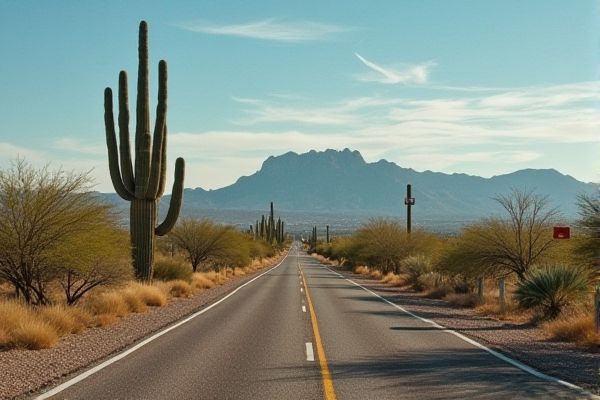
Safety and crime rates in Arizona: Statewide crime rate trends. Urban vs rural crime statistics. Safe neighborhoods advice. Local law enforcement presence. Crime prevention programs. Community watch initiatives. Emergency services accessibility. Crime reporting resources. Seasonal crime variation. State safety rankings.
Statewide crime rate trends
Arizona's crime rates have seen a significant increase, with violent crime rates surging nearly 30% from 2014 to 2017 and remaining 18% above the national average since 2014. This trend has resulted in substantial economic and societal costs, including a $20.6 billion annual impact on the state. For more in-depth coverage, visit the Chamber Business News article, which explores the implications of rising crime on Arizona's economy and society.
Urban vs rural crime statistics
In Arizona, the crime landscape varies notably between urban and rural areas. Urban centers such as Phoenix and Tucson are characterized by higher rates of property crimes and robbery. Contrarily, rural towns like Florence present significantly lower crime rates, albeit they encounter more violent crimes, including murder and aggravated assault, often exceeding national averages. Interestingly, rural regions in Arizona, similar to others, experience gun violence rates that can match or even outpace those in cities. This phenomenon is partly due to higher gun ownership rates contributing to increased instances of gun violence. For more in-depth insights into these crime rate disparities, a comprehensive overview is provided by The Kaiser Law Group.
Safe neighborhoods advice
Phoenix boasts numerous safe neighborhoods ideal for families seeking tranquility and community vitality. Areas like Anthem East, Anthem Country Club, Komatke, Carriage Trails, Colina, Desert Foothills North, and Sonoran Foothills are renowned for their low crime rates and family-friendly environments. Beyond Phoenix, cities such as Florence, Somerton, Prescott Valley, Sahuarita, and Paradise Valley shine as some of the safest in Arizona. These areas enjoy crime rates significantly lower than state and national averages, promoting a secure living atmosphere. In the heart of Phoenix, neighborhoods including Ahwatukee Foothills, Deer Valley, Laveen, North Gateway, and Rio Vista also epitomize safety, offering excellent schools and a variety of family-friendly activities and amenities. According to the Phoenix Crime Rate And Safest Neighborhoods guide, these localities remain proactive in community engagement, enhancing their reputation as safe havens.
Local law enforcement presence
The Phoenix Police Department maintains a significant local law enforcement presence, with various initiatives such as the "Virtual Block Watch" program to enhance crime prevention and a strong hiring process for both sworn and professional staff. The department also benefits from community support through the Phoenix Police Foundation, which aids in providing resources and assistance to the department and its employees.
Crime prevention programs
The Arizona Project Safe Neighborhoods program concentrates on evidence-based crime prevention through community engagement, prevention and intervention, strategic enforcement, and accountability. It utilizes data-driven approaches and fosters partnerships with law enforcement, schools, and non-government organizations to reduce violent crime and recidivism. The program particularly targets youth and transnational narcotics trafficking organizations, aiming for comprehensive community safety. For more information, you can visit the Bureau of Justice Assistance website.
Community watch initiatives
Community watch initiatives in Arizona, such as the Anthem Neighborhood Watch, involve volunteers working with local law enforcement to prevent and deter crime, promote safety, and foster a sense of community through block watch programs, community events, and training on home security and crime reporting. These programs aim to reduce crime rates, enhance neighborhood security, and encourage neighborly cooperation and communication.
Emergency services accessibility
Arizona has significantly improved its emergency services accessibility through the Next Generation 911 system, allowing responders to locate callers within 3 feet using cell phone data and enabling text and multimedia sharing to enhance response times and accuracy. This advancement is particularly beneficial in remote or sensitive situations, underscoring the critical enhancements made to the state's emergency infrastructure. To learn more about these improvements, you can visit the Next Generation 911 system and its impact on community safety.
Crime reporting resources
The Phoenix Police Department offers a valuable resource through its Citizens Online Police Reporting System, allowing individuals to report non-emergency crimes efficiently. On this platform, users can access a variety of reporting resources designed to streamline the process. Upon completion and approval of the report, individuals are provided with a tracking number and police report number, ensuring seamless follow-up and communication. To explore this convenient report filing option, you may visit the Phoenix Police Department's official website for more information.
Seasonal crime variation
In Arizona, there is a significant increase in criminal activity during the summer months, with a noticeable rise in crime from June to August compared to the rest of the year. This surge is driven by factors such as more people spending time outdoors, vacations, and heightened opportunities for crimes like burglaries, thefts, DUIs, and assaults. Understanding these trends is crucial, and more insights can be found on the Suzuki Law Offices website, which delves deeper into the reasons behind this seasonal uptick in crime. This phenomenon highlights the need for increased awareness and preventive measures to ensure public safety during these months.
State safety rankings
Arizona ranks 39th in the nation for its crime rate per 100,000 residents as of 2020, and its Public Safety Competitiveness Index has declined from 70 in 2011 to 66 in 2023, reflecting challenges in areas such as homelessness, drug overdoses, and police per capita. The state has higher than average rates of both property and violent crimes, with a violent crime rate 5% higher than the national average. To explore more about these pressing issues and their implications for Arizona, you can visit the Arizona Public Safety Competitiveness Index, which provides a comprehensive analysis of the state's standing in this critical domain.
